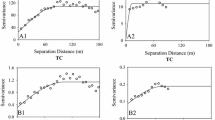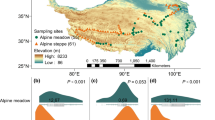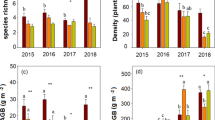Abstract
The association between biodiversity and belowground biomass (BGB) remains a central debate in ecology. In this study, we compared the variations in species richness (SR) and BGB as well as their interaction in the top (0–20 cm), middle (20–50 cm) and deep (50–100 cm) soil depths among 8 grassland types (lowland meadow, temperate desert, temperate desert steppe, temperate steppe desert, temperate steppe, temperate meadow steppe, mountain meadow and alpine steppe) and along environmental gradients (elevation, energy condition (annual mean temperature (AMT) and potential evapotranspiration (PET)), and mean annual precipitation (MAP)) based on a 2011–2013 survey of 379 sites in Xinjiang, Northwest China. The SR and BGB varied among the grassland types. The alpine steppe had a medium level of SR but the highest BGB in the top soil depth, whereas the lowland meadow had the lowest SR but the highest BGB in the middle and deep soil depths. The SR and BGB in the different soil depths were tightly associated with elevation, MAP and energy condition; however, the particular forms of trends in SR and BGB depended on environmental factors and soil depths. The relationship between SR and BGB was unimodal in the top soil depth, but SR was positively related with BGB in the middle soil depth. Although elevation, MAP, energy condition and SR had significant effects on BGB, the variations in BGB in the top soil depth were mostly determined by elevation, and those in the middle and deep soil depths were mainly affected by energy condition. These findings highlight the importance of environmental factors in the regulations of SR and BGB as well as their interaction in the grasslands in Xinjiang.
Similar content being viewed by others
References
Allan E, Weisser W W, Fischer M, et al. 2013. A comparison of the strength of biodiversity effects across multiple functions. Oecologia, 173(1): 223–237.
Ammer C. 2019. Diversity and forest productivity in a changing climate. New Phytologist, 221(1): 50–66.
Bai Y F, Wu J G, Clark C M, et al. 2012. Grazing alters ecosystem functioning and C:N:P stoichiometry of grasslands along a regional precipitation gradient. Journal of Applied Ecology, 49(6): 1204–1215.
Bessler H, Temperton V M, Roscher C, et al. 2009. Aboveground overyielding in grassland mixtures is associated with reduced biomass partitioning to belowground organs. Ecology, 90(6): 1520–1530.
Brouwer R. 1983. Functional equilibrium: sense or nonsense? Netherlands Journal of Agricultural Science, 31: 335–348.
Brown J H, Gillooly J F, Allen A P, et al. 2004. Toward a metabolic theory of ecology. Ecology, 85(7): 1771–1789.
Burke M K, Raynal D J. 1994. Fine-root growth phenology, production, and turnover in a northern hardwood forest ecosystem. Plant and Soil, 162(1): 135–146.
Burnham K P, Anderson D R. 2002. Model Selection and Multimodel Inference: A Practical Information-Theoretic Approach. Berlin: Springer Press, 1–488.
Callaway R M. 2007. Positive Interactions and Interdependence in Plant Communities. Dordrecht: Springer Press, 1–404.
Chen D M, Cheng J H, Chu P F, et al. 2016. Effect of diversity on biomass across grasslands on the Mongolian Plateau: contrasting effects between plants and soil nematodes. Journal of Biogeography, 43(5): 955–966.
Chen S H. 1986. Root System Type of Grassland Plants in Inner Mongolia. Hohhot: People’s Publishing of Inner Mongolia, 1–284. (in Chinese)
Chen S P, Wang W T, Xu W T, et al. 2018. Plant diversity enhances productivity and soil carbon storage. Proceedings of the National Academy of Sciences of the United States of America, 115(16): 4027–4032.
Cleland E E, Collins S L, Dickson T L, et al. 2013. Sensitivity of grassland plant community composition to spatial vs. temporal variation in precipitation. Ecology, 94(8): 1687–1696.
Currie D J, Paquin V. 1987. Large-scale biogeographical patterns of species richness of trees. Nature, 329(6137): 326–327.
De-Boeck H J, Lemmenss C M H M, Zavalloni C, et al. 2008. Biomass production in experimental grasslands of different species richness during three years of climate warming. Biogeosciences, 5(2): 585–594.
Fick S E, Hijmans R J. 2017. Worldclim 2: New 1-km spatial resolution climate surfaces for global land areas. International Journal of Climatology, 37(12): 4302–4315.
Fraser L H, Pither J, Jentsch A, et al. 2015. Worldwide evidence of a unimodal relationship between productivity and plant species richness. Science, 349(6245): 302–305.
Guo Q F, Berry W L. 1998. Species richness and biomass: dissection of the hump-shaped relationships. Ecology, 79(7): 2555–2559.
Guo Q F, Kelt D A, Sun Z Y, et al. 2013. Global variation in elevational diversity patterns. Scientific Report, 3: 3007, doi: https://doi.org/10.1038/srep03007.
Hooper D U, Chapin F S, Ewel J J, et al. 2005. Effects of biodiversity on ecosystem functioning: a consensus of current knowledge. Ecological Monographs, 75(1): 3–35.
Isbell F, Gonzalez A, Loreau M, et al. 2017. Linking the influence and dependence of people on biodiversity across scales. Nature, 546(7656): 65–72.
Jackson R B, Canadell J, Ehleringer J R, et al. 1996. A global analysis of root distributions for terrestrial biomass. Oecologia, 108(3): 389–411.
Keddy P A. 1992. Assembly and response rules: two goals for predictive community ecology. Journal of Vegetation Science, 3(2): 157–164.
Koerner C. 2007. The use of ‘altitude’ in ecological research. Trends in Ecology and Evolution, 22(11): 569–574.
Liu L L, Cheng J H, Liu Y H, et al. 2016a. Relationship of productivity to species richness in the Xinjiang temperate grassland. PloS ONE, 11(4): E0154026, doi: https://doi.org/10.1371/journal.pone.0154026.
Liu L L, Sheng J D, Cheng J H, et al. 2016b. Relationship between plant species characteristics and climate factors in different grassland types of Xinjiang. Acta Prataculturae Sinica, 25(7): 1–12. (in Chinese)
Lomolino M V. 2001. Elevation gradients of species-density: historical and prospective views. Global Ecology and Biogeography, 10(1): 3–13.
Loreau M. 2000. Biodiversity and ecosystem functioning: recent theoretical advances. Oikos, 91(1): 3–17.
Ma W H, He J S, Yang Y H, et al. 2010. Environmental factors covary with plant diversity-productivity relationships among Chinese grassland sites. Global Ecology and Biogeography, 19(2): 233–243.
Mueller K, Tilman D, Fornara D A, et al. 2013. Root depth distribution and the diversity-productivity relationship in a long-term grassland experiment. Ecology, 94(4): 787–793.
Ni J. 2003. Plant functional types and climate along a precipitation gradient in temperate grasslands, north-east China and south-east Mongolia. Journal of Arid Environments, 53(4): 501–516.
R Development Core Team. 2012. R: A Language and Environment for Statistical Computing. Vienna: R Foundation for Statistical Computing.
Sala O E. 2000. Global biodiversity scenarios for the year 2100. Science, 287(5459): 1770–1774.
Sanchez G. 2013. PLS Path Modeling with R. Berkeley: Trowchez Editions.
Su R, Cheng J, Chen D, et al. 2017. Effects of grazing on spatiotemporal variations in community structure and ecosystem function on the grasslands of Inner Mongolia, China. Scientific Reports, 7(1): 40, doi: https://doi.org/10.1038/s41598-017-00105-y.
Sun Y F, Wan H W, Zhao Y J, et al. 2018. Spatial patterns and drivers of root turnover in grassland ecosystems in China. Chinese Journal of Plant Ecology, 42(3): 337–348. (in Chinese)
Tilman D. 1999. The ecological consequences of changes in biodiversity: a search for general principles. Ecology, 80(5): 1455–1474.
Trabucco A, Zomer R J. 2009. Global Aridity Index (Global-Aridity) and Global Potential Evapo-Transpiration (Global-PET) Geospatial Database. CGIAR Consortium for Spatial Information. [2019-04-20]. http://www.csi.cgiar.org.
Turnbull L A, Isbell F, Purves D W, et al. 2016. Understanding the value of plant diversity for ecosystem functioning through niche theory. Proceedings of the Royal Society B-Biological Sciences, 283(1844): 1–9.
Xu P. 1993. Grassland Resources and Their Utilization in Xinjiang. Urumqi: Xinjiang Science and Technology Publishing Press, 1–400. (in Chinese)
Wang J J, Pan F, Soininen J, et al. 2016. Nutrient enrichment modifies temperature-biodiversity relationships in large-scale field experiments. Nature Communications, 7: 13960, doi: https://doi.org/10.1038/ncomms13960.
Wang J W, Zhao C Z, Zhao L C, et al. 2018. Response of root morphology and biomass of Phragmites australis to soil salinity in inland salt marsh. Acta Ecologica Sinica, 38(13): 4843–4851. (in Chinese)
Zhu G L, Li J, Wei X H, et al. 2017. Longitudinal patterns of productivity and plant diversity in Tibetan alpine grasslands. Journal of Natural Resources, 32(2): 210–222. (in Chinese)
Acknowledgements
This research was supported by the National Natural Science Foundation of China (U1603235, 31660127) and the Tianshan Innovation Team Plan of Xinjiang (2017D14009).
Author information
Authors and Affiliations
Corresponding author
Rights and permissions
About this article
Cite this article
Yang, Y., Li, M., Ma, J. et al. Changes in the relationship between species richness and belowground biomass among grassland types and along environmental gradients in Xinjiang, Northwest China. J. Arid Land 11, 855–865 (2019). https://doi.org/10.1007/s40333-019-0068-8
Received:
Revised:
Accepted:
Published:
Issue Date:
DOI: https://doi.org/10.1007/s40333-019-0068-8




